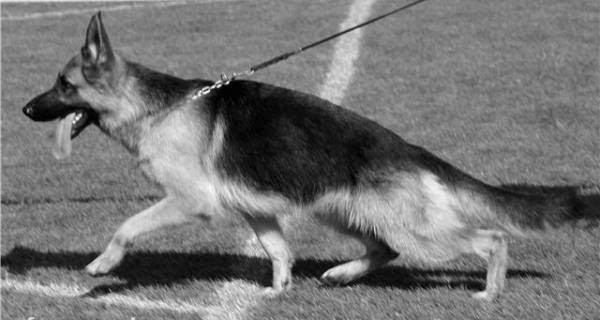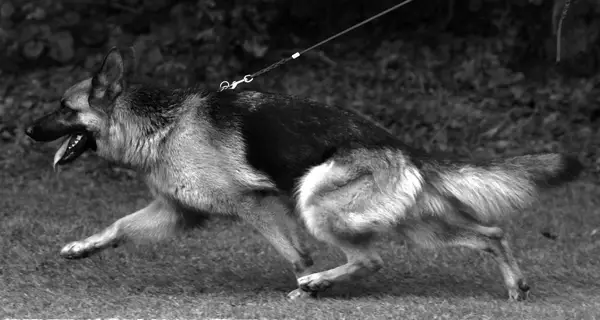
This is a placeholder text
Group text
by waleed786 on 12 May 2014 - 19:05
Also am right in saying that the thigh joint is taken at the half way mark of the thigh?
by Ibrahim on 12 May 2014 - 19:05
Not exactly, not really, you have to imagine how bones are laid inside and spot it.
.jpg)
.jpg)
Here is a try to locate thigh joint on a dog
.jpg)
by Ibrahim on 12 May 2014 - 20:05
Just for clarification of thigh joint and point of thigh joint
.jpg)
Point of thigh joint you can easily spot on a dog by looking at where topography of lower thigh start changing to upwards, at a notch you wouldn't miss.
by susie on 12 May 2014 - 21:05
Looking around searching for pics of dogs in motion I just found these 2 pics - I only changed them into black and white, no photshop involved

#1 a deep back, overangulated rear, arch, restricted frontreach...

# 2 great frontreach, almost no arch, rear a littlelittlebit overangulated, beautiful dog
It´s the same dog, only difference - in
#1 very tense leash, slow trot ( picture might be taken during the "walking phase", the handler walking fast ,the dog focussed to the owner in front )
#2 loose leash, perfect peed during trot
Ibrahim, I can´t help with anatomy, but I know that all the dogs with restricted frontreach do have short upperarms, that´s a fact.
There are lines known for producing them.
The pictures of GSL almost always show dogs restricted by the leash. Even in the "off leash" round they are restricted in movement due to the lack of speed of the handlers ( without the leash at least the males are too fast for humans ) combined with the heeling command. They don´t run "free".
Really difficult to find good pics...
by Ibrahim on 12 May 2014 - 21:05
I understand Susie, excellent, no, very excellent explanation from 1st hand experience. If you didn't say it I would have thought they were two different dogs looking at their backs. Thanks again, I like it when I see a good convincing explanation ![]()
by susie on 12 May 2014 - 21:05
I "borrowed" your skeleton... sorry, I had to improvise
 At these points a skilled handler does change the rear angulation, maybe it´s visible that during the same time the back becomes shorter for the eye, the croup becomes steeper, and an "arch" may appear. A good handler is able to find the "perfect balance", but you won´t see the "natural" dog any more.
At these points a skilled handler does change the rear angulation, maybe it´s visible that during the same time the back becomes shorter for the eye, the croup becomes steeper, and an "arch" may appear. A good handler is able to find the "perfect balance", but you won´t see the "natural" dog any more.![]()
by SitasMom on 12 May 2014 - 23:05
Susie, the FCI standard states when troting....."The head pushed forward and the slightly raised tail result in a consistent, smooth trot showing a gently curved, uninterrupted upper line from the ear tips over the neck and back to the end of the tail."
When trotting an arch is expected.
by GSD Lineage on 13 May 2014 - 08:05
I found some images of a more current top US dog.
I found it interesting to it moving on hard ground and grass. On the grass of course more extended. The stack image, so you can see the dog standing.
.png)

Credits: Bestinshowdaily/facebook/google
If you do a search for side gait and German shepherd dog, you get some interesting stuff
by susie on 13 May 2014 - 15:05
Not being picky, Sitasmom, but I think that there is a difference between a "gentle curve" and an "arch".
I love good looking / good gaiting showlines, but several do have faults like "arches" or "roached backs", overangulated rears or steep and short upperarms, we can´t deny this.
by SitasMom on 13 May 2014 - 19:05
Susie, IMO a slight arch or bend at the loin is not a roach.
How about pasterns?
AKC - The pasterns are strong and springy and angulated at approximately a 25-degree angle from the vertical.
FCI - The pastern has a length of approx. 1/3 of the forearm, and has an angle of approx. 20° to 22° to the forearm. A slanted pastern (more than 22°) as well as a steep pastern (less than 20°) impairs the suitability for work, particularly the stamina.
Contact information Disclaimer Privacy Statement Copyright Information Terms of Service Cookie policy ↑ Back to top





